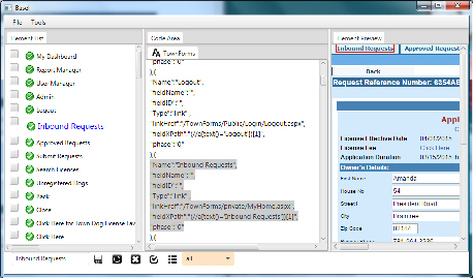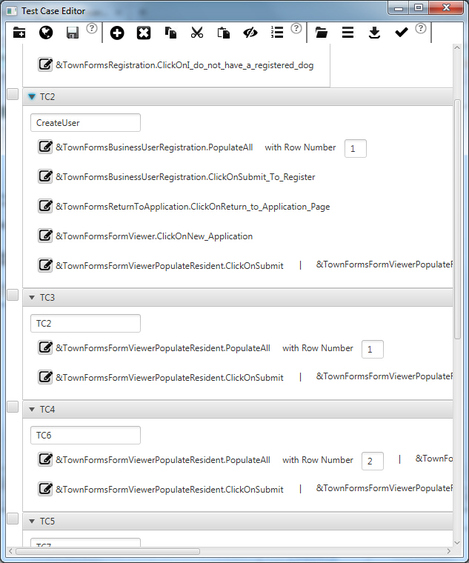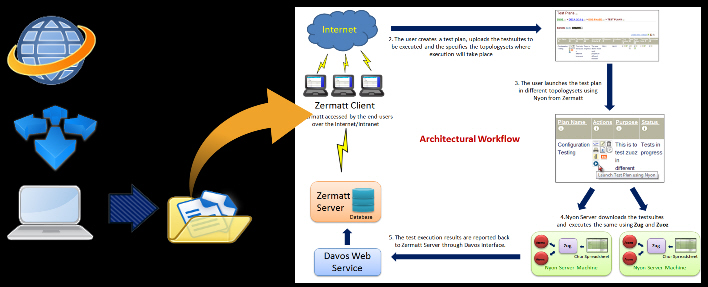
For web based applications, Basel eliminates the necessity to write code manually, and is Automature's superior "click-and-create" answer to the "record-n-play" feature available in several other similar products. With Basel, the creation of test cases is a breeze, involving a two phased approach, where first the user introduces the pages to be tested, reviewing the page element names, and then references those page elements by name, to populate, click or verify the fields, links and other controls contained in them. Since the data used for populating forms is stored in a comma-separated-value (CSV) file, the tests are completely data-driven, The code is object oriented, modular, and highly comprehensible and maintainable.
But the best reason to use Basel is to easily generate, with just a few mouse clicks, comprehensive verification for every single HTML element on your pages. Yes, you read that correctly. Verify for presence, visibility or modifiability. No hidden surprises after you publish your application! Guaranteed.
But the best reason to use Basel is to easily generate, with just a few mouse clicks, comprehensive verification for every single HTML element on your pages. Yes, you read that correctly. Verify for presence, visibility or modifiability. No hidden surprises after you publish your application! Guaranteed.

Object Oriented Test Design
Basel's approach to automated testcase design is simpler than "record n playback". It approaches the problem as an experienced automation architect would. It automatically analyzes the pages in the web application, and allows the tests to refer to the elements by their page name and field name. It does a pretty decent job at guessing the names of the various elements, but it allows the reviewer to choose other names too. Because the elements are now addressable by their semantic name, rather than an HTML identifier or xpath, the test logic created is immune from small changes in the page structure, thus providing the advantages of "object-oriented design" while also leveraging the simplicity of the "record-n-playback" approach.
Data Driven Testing
All data for populating fields and web-forms. is read from CSV (comma-separated-value) files, which can be edited using any spreadsheet tool like Excel or Calc. This means that the user needs to record the page once only. Subsequent data can be entered directly into a spreadsheet. This dramatically reduces the time to enter additional test scenarios! Basel can also be used to save different data sets directly into the CSV by making the changes directly on the web form.
Intuitive Test Case Creation
In Basel, each testcase is a sequence of three kinds of steps, viz. populate one or more fields, click on a button or link, or verify the contents of some web element. The testcase designer identifies the page object, and constructs the testcase by placing any of these three actions sequentially in steps. Once done, the test suite can be saved and is ready for execution.
Create Once Run Forever
Record-n-Playback tools can populate forms with static data, but what about fields that require unique values, such as email addresses, or even dates that are related to the day of execution? Basel can populate specific fields with randomly generated data, that conforms to a specified pattern. This feature allows you to execute the tests repeatedly without the need to insert special code, or modify the test.
Handling Pesky Verifications
Anybody can verify static textual content, but with Basel the testcase designer has the power to verify even randomly generated content, used to populate the form. And verification is not limited to just textual content. It has the ability to delve inside cells within tabular data, and verify selections for dropdowns or checkboxes too. And with Basel, negative testing is so simple, you would want to use it just for this feature alone! No programming required. Period.
Execution and Reporting Ready Testsuites
The test tests created by Basel are immediately ready for execution interactively through Spark, Automature's IDE, or through Zermatt, Automarure's Planning and Reporting Framework. Executing the testsuite through Zermatt automatically populates the testcases and their descriptions into Zermatt..
Please visit Downloads to download the latest release of Basel.
Basel's approach to automated testcase design is simpler than "record n playback". It approaches the problem as an experienced automation architect would. It automatically analyzes the pages in the web application, and allows the tests to refer to the elements by their page name and field name. It does a pretty decent job at guessing the names of the various elements, but it allows the reviewer to choose other names too. Because the elements are now addressable by their semantic name, rather than an HTML identifier or xpath, the test logic created is immune from small changes in the page structure, thus providing the advantages of "object-oriented design" while also leveraging the simplicity of the "record-n-playback" approach.
Data Driven Testing
All data for populating fields and web-forms. is read from CSV (comma-separated-value) files, which can be edited using any spreadsheet tool like Excel or Calc. This means that the user needs to record the page once only. Subsequent data can be entered directly into a spreadsheet. This dramatically reduces the time to enter additional test scenarios! Basel can also be used to save different data sets directly into the CSV by making the changes directly on the web form.
Intuitive Test Case Creation
In Basel, each testcase is a sequence of three kinds of steps, viz. populate one or more fields, click on a button or link, or verify the contents of some web element. The testcase designer identifies the page object, and constructs the testcase by placing any of these three actions sequentially in steps. Once done, the test suite can be saved and is ready for execution.
Create Once Run Forever
Record-n-Playback tools can populate forms with static data, but what about fields that require unique values, such as email addresses, or even dates that are related to the day of execution? Basel can populate specific fields with randomly generated data, that conforms to a specified pattern. This feature allows you to execute the tests repeatedly without the need to insert special code, or modify the test.
Handling Pesky Verifications
Anybody can verify static textual content, but with Basel the testcase designer has the power to verify even randomly generated content, used to populate the form. And verification is not limited to just textual content. It has the ability to delve inside cells within tabular data, and verify selections for dropdowns or checkboxes too. And with Basel, negative testing is so simple, you would want to use it just for this feature alone! No programming required. Period.
Execution and Reporting Ready Testsuites
The test tests created by Basel are immediately ready for execution interactively through Spark, Automature's IDE, or through Zermatt, Automarure's Planning and Reporting Framework. Executing the testsuite through Zermatt automatically populates the testcases and their descriptions into Zermatt..
Please visit Downloads to download the latest release of Basel.


